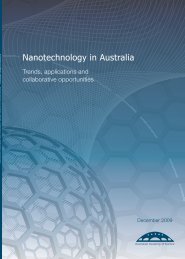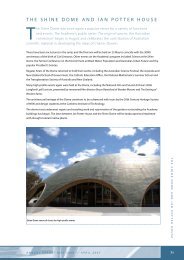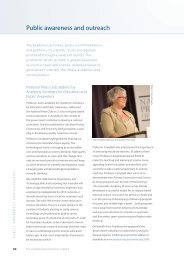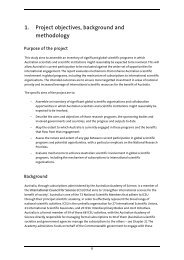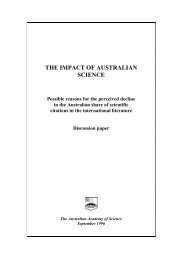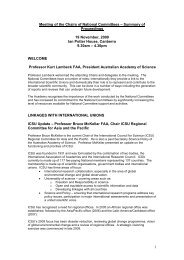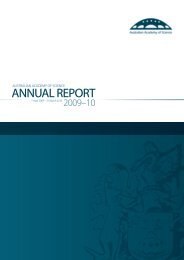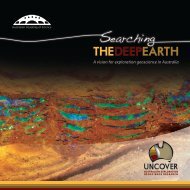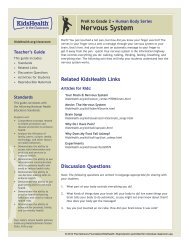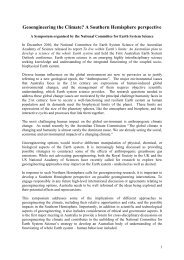Australia's Major National Research Facilities - Australian Academy ...
Australia's Major National Research Facilities - Australian Academy ...
Australia's Major National Research Facilities - Australian Academy ...
You also want an ePaper? Increase the reach of your titles
YUMPU automatically turns print PDFs into web optimized ePapers that Google loves.
increasingly wide variety of methods ranging from the classical 2DGE to the latest shotgun proteomics methods using state of the art<br />
FT-MS. Alongside this there will be a gradual blurring of the distinction between target protein identification and the subsequent<br />
characterisation with high throughput techniques being applied to protein-protein and protein-ligand interactions, mutagenesis studies,<br />
signalling cascades and ‘structuromics’.<br />
4.4. NMR Spectroscopy and Imaging<br />
4.4.1. Historical Perspective<br />
The phenomenon whereby the atomic nuclei in matter absorb electromagnetic radiation when immersed in a magnetic field (the<br />
phenomenon of nuclear magnetic resonance) was discovered in 1945. Viewed initially as equipment that was only of interest to<br />
physicists, NMR spectrometers in a comparatively short time, were widely installed in chemistry laboratories to identify and quantify<br />
even complex molecules. A slow incremental rise in the power of these instruments, particularly since the 1970s, has provided<br />
molecular life-scientists with a potent tool for the determination of the structure of molecules that contain thousand of atoms. The<br />
importance of NMR in several scientific fields has been underscored by the award of the Nobel Prize in Physics to the original<br />
discoverers (Bloch & Purcell) in 1952, in Chemistry (Ernst, and Wüthrich) in 1991 and 2001, respectively, and in Physiology or<br />
Medicine (Lauterbur and Mansfield) in 2002.<br />
The most prominent feature, and the most costly single component, of an NMR spectrometer is its magnet. The highest magnetic field<br />
currently commercially available is 21.1 tesla (T) while at least one company (Bruker, Germany) is working on a 23.5 T magnet in<br />
which 1 H nuclei resonate at 1 gigahertz (GHz). The quest for higher magnetic fields is related to increased sensitivity to detection of<br />
the nuclei, an increase in separation between spectral lines (dispersion) and enhancement of special effects (in particular the so called<br />
TROSY effect) that provide structural data on relatively immobile molecules such as membrane proteins.<br />
4.4.2. Australia<br />
This nation has a vibrant community of scientists and students (and a society with ~200 members, ANZMAG) whose primary<br />
technological focus is NMR spectroscopy. There are two 800 MHz and nine 600 MHz spectrometers at various locations around the<br />
country; and around 40 lower field instruments all with modern superconducting magnets.<br />
Australia has no 900 MHz spectrometers in spite of this technology now being ~8 years old. However, such an instrument is likely in<br />
the near future at the IMB at the University of Queensland.<br />
4.4.3. Proposition<br />
A 1 GHz facility be planned for the Sydney region. This would be part of a <strong>National</strong>ly networked system with the grid containing the<br />
two extant 800 MHz spectrometers at the University of Melbourne and the <strong>Australian</strong> <strong>National</strong> University, and the likely 900 MHz<br />
spectrometer at the University of Queensland. The proposed instrument would be operational in ~5 years. It would place Australia<br />
back at the cutting edge of NMR research and its advanced applications.<br />
The scientific argument for such an instrument would be made in a detailed submission akin to that developed for an MNRF bid made<br />
4 years ago.<br />
22



